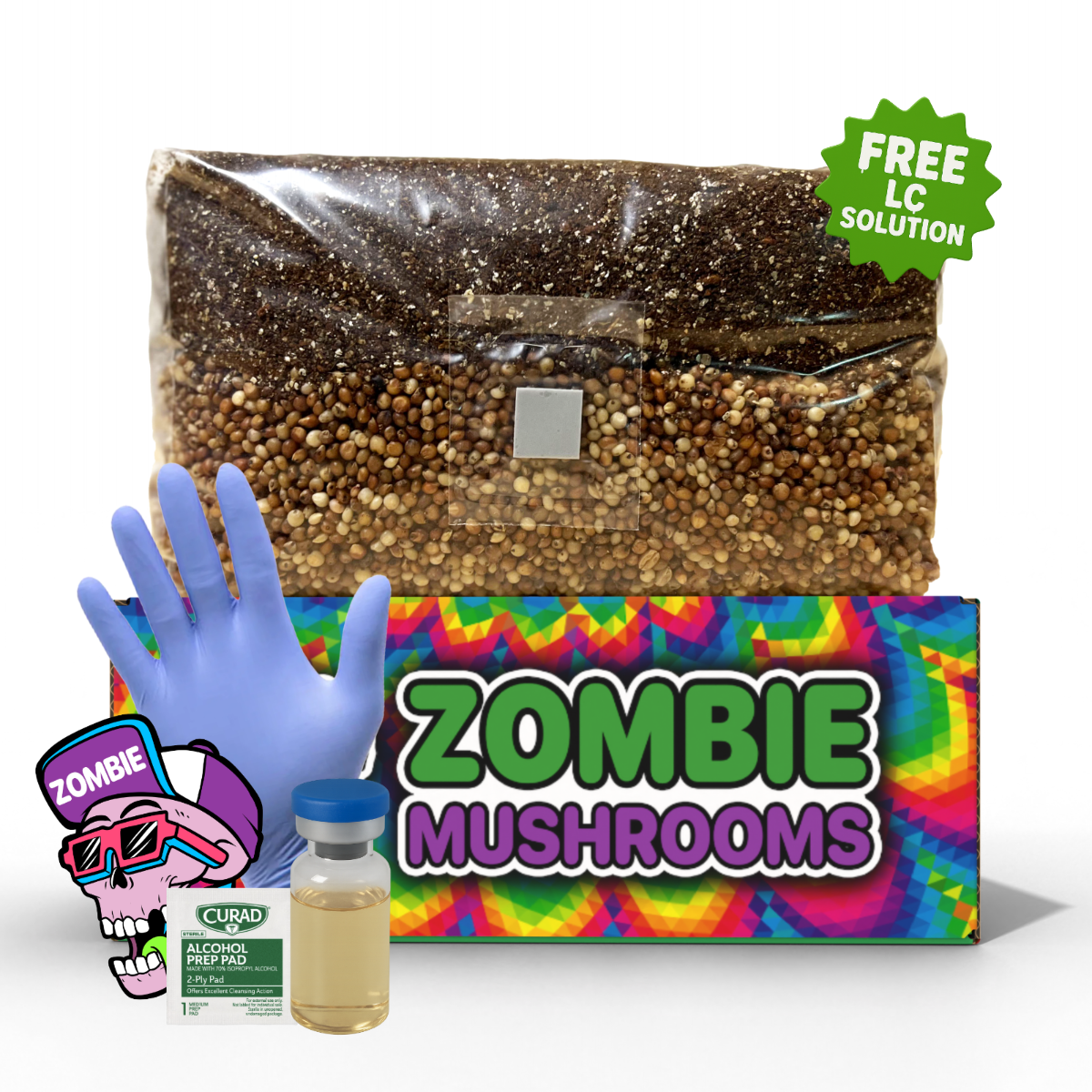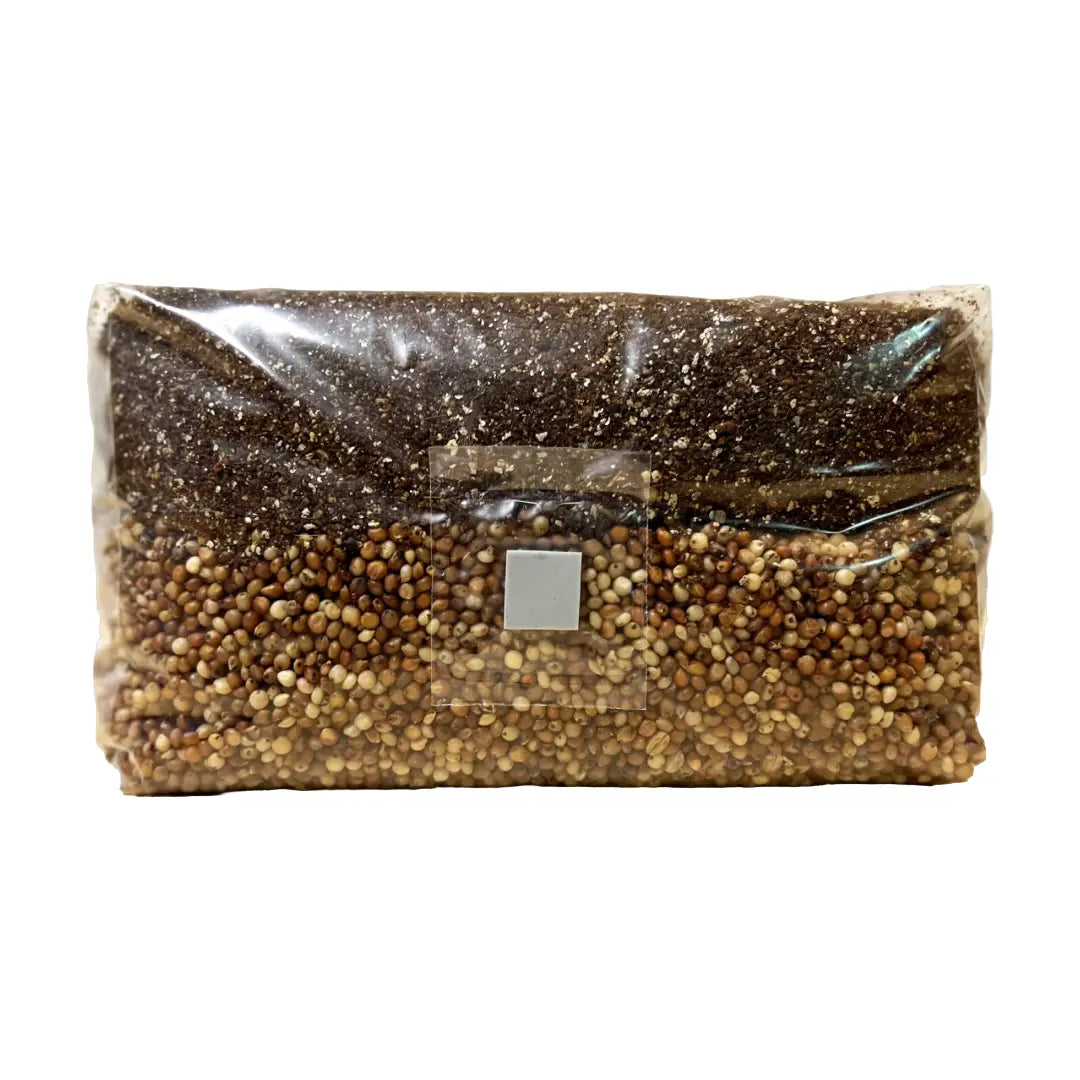⬇️ Prefer to listen instead? ⬇️

- Parasol mushrooms (Macrolepiota procera) need 6 to 12 months to fully colonize before fruiting.
- Optimal fruiting conditions require 90% humidity and temperatures between 16 to 20°C.
- One colonized bed can yield mushrooms for several years.
- A 5:1 substrate-to-spawn ratio is recommended for best growth.
- Outdoor cultivation is more effective because of natural moisture and soil contact.
Growing gourmet mushrooms at home is very popular now. And one popular type is the striking and flavorful Parasol mushroom, or Macrolepiota procera. While these mushrooms are often found in the wild, growing them at home lets you enjoy this forest mushroom in a tasty, lasting way year after year. This guide tells you why growing parasols is different, shows you how to grow them step-by-step, and helps you figure out if it's right for you. For beginners, our mushroom grow kits make the process simple. Providing everything you need to start growing parasols at home with ease.

What Are Parasol Mushrooms (Macrolepiota procera)?
Parasol mushrooms, scientifically named Macrolepiota procera, are well-liked wild edible mushrooms in Europe and North America. Their name comes from their unique cap, which looks like an umbrella or "parasol". It often has brown scales. A long, thin stem holds up the cap and has a pattern like snakeskin.
Characteristics of Macrolepiota procera:
- Cap: 8 to 20 cm wide, scaly surface, turns flat like an umbrella when mature
- Stem: Tall (up to 30 cm), slender with snake-skin patterned scales
- Gills: Free, white to pale cream, densely packed
- Spore print: White to pale cream
- Habitat: Meadows, grasslands, forest clearings, especially near the edge of wooded areas
- Season: Late spring through fall, peaking in summer
Nutritional Value
Parasol mushrooms are healthy and interesting:
- Protein: A good substitute for meat
- Fiber: Helps digestion
- B Vitamins: Have a lot of B2 (riboflavin) and niacin
- Potassium & Phosphorus: Helps cells stay healthy and supports body functions
They don't have much fat or carbs, so they work for people eating healthy or vegetarian meals.

Why Grow Parasol Mushrooms at Home?
They are admired in nature, but they are hard to grow for stores, so you don't often see them there. Learning how to grow parasol mushrooms at home gives you a steady, safe, and nice way to get this special mushroom.
Key Benefits:
- Great Taste: They taste nutty, like almond-meat. This flavor is special and good, especially grilled or cooked in a pan.
- Can Harvest for Years: Set up your bed once. You might pick mushrooms every year with little work.
- Safe to Eat: Finding real parasols in the wild can be hard. Some toxic ones look similar. Growing them at home makes sure you have the right kind.
- Fits in Your Garden: Growing parasols works well in gardens, compost piles, or natural setups.
- Learn Something: It's fun and teaches families things, especially kids learning about nature and growing food in a good way.

Is Parasol Mushroom Cultivation Worth the Effort?
You can grow parasols, but they aren't the simplest mushrooms for new growers. Other types, like oyster or king trumpet mushrooms, grow faster. Parasols take longer to fruit. They also need specific weather and soil conditions.
Growth Timeline:
| Stage | Time Required |
|---|---|
| Substrate Prep & Inoculation | ~1 Day |
| Mycelium Colonization | 6–12 Months |
| Fruiting Initiation | 1–2 Weeks |
| First Harvest | After 9–12 Months |
Yield Potential
If conditions are right, one bed can give you several pounds of mushrooms when they fruit. What's more, if you take care of the mycelium beds well, they can keep fruiting for 5 to 7 years. This makes growing parasols a real long-term project.
Pros vs. Cons
| Pros | Cons |
|---|---|
| Unique gourmet flavor | Long wait time |
| Perennial harvests | Sensitive to environmental shifts |
| Safer than wild foraging | Spawn availability may be limited |
| Natural integration in outdoor gardens | Not ideal for tight indoor spaces or beginners |

Supplies You'll Need
To grow parasols at home, you need a basic setup. It should help the mycelium grow and the mushrooms fruit. This can be outdoors or in a well-controlled indoor spot.
Materials Checklist:
- ✅ Parasol Spawn: Use good Macrolepiota procera grain spawn bought from a seller you trust
- ✅ Substrate: Best options are pasteurized hardwood chips, straw, or a mix of both
- ✅ Growing Containers: Buckets with holes, raised beds, fabric grow bags, or forest soil patches
- ✅ Watering Equipment: Misting bottles or watering cans to keep things moist
- ✅ Thermometer + Hygrometer: Check temperature and humidity correctly
- ✅ Shovel or compost fork: Helps with mixing and spreading substrate
If putting spawn into a ground bed, make sure it doesn't have too many roots or bad weeds.

Step-by-Step Guide to Grow Parasol Mushrooms
Step 1: Prepare Your Substrate
Parasol mushrooms grow well on broken down plant stuff. You must pasteurize it to stop bad stuff from growing.
How to Pasteurize Straw or Wood Chips:
- Soak material in water (~160°F / 71°C)
- Keep that temperature for 60–90 minutes
- Drain well using a mesh bag or colander
- Let it cool to below 77°F (25°C) before mixing with spawn
Pasteurizing kills bacteria and fungi that compete with the mycelium. But it keeps the nutrients the mycelium needs to grow.
Step 2: Inoculation
Here, you put the mushroom spawn into the substrate. Using 1 part spawn to 5 parts substrate helps the mycelium grow faster and gives you a better chance of getting mushrooms.
Inoculation Tips:
- Break spawn into small pieces and mix evenly
- Place mixture into containers or spread evenly across a garden bed
- Don't pack the substrate down — mushrooms need air
- Water lightly after putting in the spawn to keep it moist
Step 3: Colonization Phase
This is when you wait for the mycelium to spread under the surface. Don't mess with the substrate or move the containers while this is happening. This is important.
Best Practices:
- Keep shaded — indirect sun or light tree cover is good
- Water gently once a week, especially when it's dry
- Leave the area alone; mycelium grows best when not disturbed
- Watch for white growth (mycelial threads) near the surface after months
Studies show it takes 6 to 12 months for the Macrolepiota procera mycelium to fill the substrate [1].
Step 4: Initiating Fruiting Conditions
To make the mushrooms start growing (“pinning”), set things up like late summer or early fall:
- Reduce ambient temperature — Aim for 60 to 68°F (16 to 20°C) if possible
- Increase humidity — Use fabric covers or misting to keep it around 90% RH
- Allow ventilation — Remove lids or choose containers that breathe
- Expose to indirect light — Natural indirect light helps pins form
Look for pins (small mushroom shapes) 7 to 10 days after you start these steps.
Step 5: Harvest with Care
Picking parasol mushrooms feels good. When the caps are about 3 inches wide, it's time to pick them.
Harvesting Guidelines:
- Use a clean, sharp knife at the base
- Handle gently so you don't bruise them
- Store right away or start drying to keep the flavor
- Don't step on or disturb the mycelium around the base. This helps future flushes.

Storing and Preserving Macrolepiota procera
Fresh parasols don't last long. But you can store them in a few ways:
| Method | Duration | Benefits |
|---|---|---|
| Refrigeration (Paper Bag) | 5–7 Days | Keeps them somewhat moist without getting moldy |
| Drying (Dehydrator or Sun) | 6–12 Months | Flavor gets stronger, good for soups and sauces |
| Sauté & Freeze | 3–6 Months | Good for making large amounts of prepared mixes |
Dried mushrooms can be ground into powder for seasoning or used in broth bases.

Culinary Uses for Homegrown Parasol Mushrooms
You can use parasol mushrooms in many ways. They work in simple and fancy meals. Here are some ways people like to cook them:
Culinary Ideas:
- Grilled Skewers: Large caps sliced with rosemary and veggies
- Stuffed Parasol Caps: Filled with cheese, walnuts, and herbs
- Crispy Parasol Schnitzel: Dipped in egg and breadcrumbs, fried
- Creamy Risotto: Dried parasol rehydrated and added at the end
- Mushroom & Leek Soup: Smooth or chunky, their flavor makes the broth better
Parasols have a deep “umami” taste. They can easily be used instead of meat in many dishes.

Indoor vs Outdoor Cultivation
Growing indoors gives you control. But growing outdoors is simpler and works well over time.
| Factor | Indoor | Outdoor |
|---|---|---|
| Temperature Control | High (greenhouse or closet grows) | Needs to handle seasonal changes |
| Space | Limited | More room to grow |
| Maintenance | Need to watch often | Little work after putting spawn |
| Yield Potential | Moderate | High if placed and kept well |
| Feasibility for Parasol Mushrooms | Difficult | Ideal environment |
If you are new to this, good places are garden edges near trees, shady yards, and areas with mulch.

Common Challenges and Solutions
Growing parasol mushrooms can have some common problems:
Common Issues & Fixes:
- Contamination from mold or bacteria — Use clean tools and pasteurized substrate
- Inconsistent humidity — Use mulch or misting systems
- Inadequate colonization — Keep temps steady between 18 to 25°C while mycelium grows
- Spawn unavailability — Order ahead from known mushroom labs or groups
- Pest and wildlife interference — Put mesh around beds if animals dig there
Watching and not doing too much is better than trying too hard.
Final Thoughts: Should You Grow Parasol Mushrooms?
If you want to grow mushrooms fast to sell, or just on small shelves, parasols might not be what you need. But if you garden at home, love cooking, or just like mushrooms, and want a special, hard-to-find type that comes back year after year — waiting a long time is worth it.
Growing parasols at home takes patience. It makes you think about nature. And it feels good to get them. It's like planting trees or making wine. You make something that gets better as time passes.
💡 Ready to start? Look at our premium grow kits and other mushroom growing supplies. They can help turn your backyard into a place for growing gourmet mushrooms.



